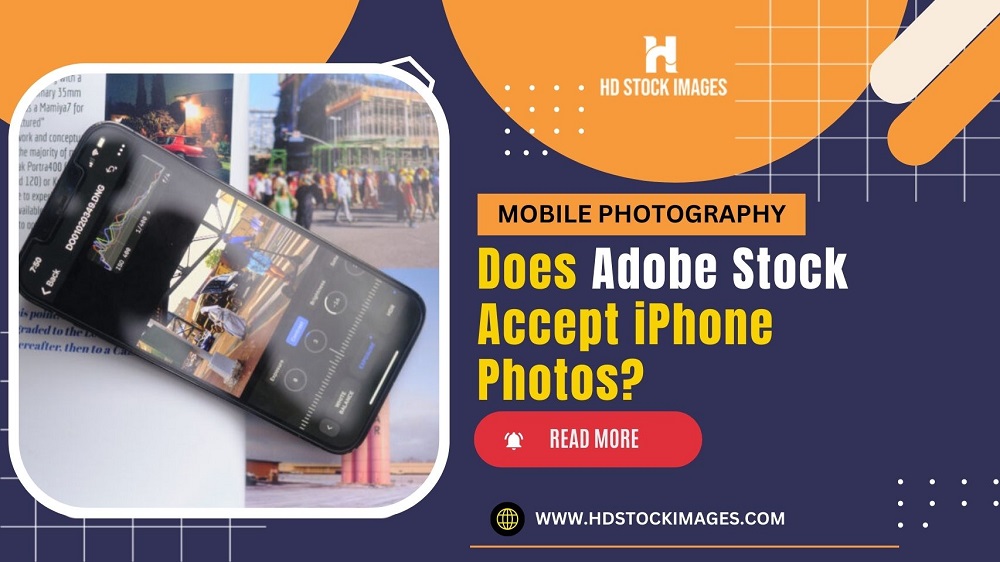1. Introduction
In an era where smartphones have become ubiquitous and their cameras increasingly sophisticated, mobile photography has surged in popularity. Capturing breathtaking moments and artistic shots has never been more accessible. With this surge, many aspiring photographers are wondering about the avenues to showcase their mobile photography skills. Adobe Stock, a prominent stock photography platform, stands out as a potential avenue for photographers to share their work with a global audience. However, a common question arises: Can iPhone photos truly make the cut on a professional platform like Adobe Stock? In this blog post, we'll delve into the world of mobile photography and Adobe Stock, exploring the guidelines and tips for submitting iPhone photos to this creative marketplace. If you're eager to turn your iPhone captures into a potential source of recognition and income, read on to discover the ins and outs of mobile photography submissions on Adobe Stock.Also Read This: How to Make Money with Rumble and Boost Your Earnings Using Its Tools
2. The Rise of Mobile Photography
 In the not-so-distant past, the idea of creating high-quality photographs using a device that fits in your pocket seemed like a far-fetched notion. However, advancements in technology have brought us to an era where mobile photography is not only possible but has also gained immense popularity. The evolution of mobile phone cameras has been nothing short of remarkable, with manufacturers constantly pushing the boundaries of what these compact lenses can achieve.What has truly fueled the meteoric rise of mobile photography is the accessibility and convenience it offers. Almost everyone carries a smartphone with a camera capable of capturing impressive shots. This democratization of photography means that anyone can turn everyday scenes into compelling visuals. From picturesque landscapes to candid street photography, the creative potential of iPhone photography knows no bounds.Furthermore, the rise of social media platforms like Instagram has created a global stage for sharing these mobile captures. Users are no longer limited to sharing personal moments; they're also showcasing their artistic prowess to a diverse and engaged audience. As a result, mobile photography has not only become a creative outlet but a means of establishing personal brands and even careers.Stay tuned as we explore how this surge in mobile photography aligns with platforms like Adobe Stock, and whether your iPhone photos can truly find a place in the world of professional imagery.
In the not-so-distant past, the idea of creating high-quality photographs using a device that fits in your pocket seemed like a far-fetched notion. However, advancements in technology have brought us to an era where mobile photography is not only possible but has also gained immense popularity. The evolution of mobile phone cameras has been nothing short of remarkable, with manufacturers constantly pushing the boundaries of what these compact lenses can achieve.What has truly fueled the meteoric rise of mobile photography is the accessibility and convenience it offers. Almost everyone carries a smartphone with a camera capable of capturing impressive shots. This democratization of photography means that anyone can turn everyday scenes into compelling visuals. From picturesque landscapes to candid street photography, the creative potential of iPhone photography knows no bounds.Furthermore, the rise of social media platforms like Instagram has created a global stage for sharing these mobile captures. Users are no longer limited to sharing personal moments; they're also showcasing their artistic prowess to a diverse and engaged audience. As a result, mobile photography has not only become a creative outlet but a means of establishing personal brands and even careers.Stay tuned as we explore how this surge in mobile photography aligns with platforms like Adobe Stock, and whether your iPhone photos can truly find a place in the world of professional imagery.Also Read This: Simplifying Commercial Usage with Imago Images Licensing Options
3. Adobe Stock: A Platform for Photographers
 In the expansive realm of stock photography, Adobe Stock has emerged as a premier platform for photographers seeking to share their work and potentially earn from their passion. As part of the Adobe Creative Cloud ecosystem, Adobe Stock offers a seamless integration that allows photographers to showcase their images to a vast global audience, including designers, marketers, and content creators.
In the expansive realm of stock photography, Adobe Stock has emerged as a premier platform for photographers seeking to share their work and potentially earn from their passion. As part of the Adobe Creative Cloud ecosystem, Adobe Stock offers a seamless integration that allows photographers to showcase their images to a vast global audience, including designers, marketers, and content creators.The benefits of contributing to Adobe Stock are manifold
Global Reach and Exposure: Adobe Stock boasts a massive user base, including professionals and businesses from around the world. This means that your iPhone photos have the potential to reach a diverse audience and be incorporated into various creative projects.Earning Potential: Beyond the joy of sharing your work, Adobe Stock offers a royalty payment system for each licensed image. This provides photographers with a chance to turn their hobby into a revenue stream, with earnings varying based on factors such as image licensing type and usage.Integration with Creative Cloud Tools: Adobe Stock is seamlessly integrated with popular Adobe Creative Cloud applications like Photoshop and Illustrator. This integration enables designers to access and use your photos directly in their projects, increasing the likelihood of your work being selected.By now, you might be wondering whether Adobe Stock accepts iPhone photos. The answer is a resounding yes, but there are certain guidelines and considerations you should keep in mind to ensure your submissions meet the platform's standards. In the next section, we'll delve into the specifics of submitting iPhone photos to Adobe Stock, from technical requirements to content guidelines and artistic considerations.Also Read This: Try Photorealistic AI Image Generation: A Comprehensive Guide
4. Submission Guidelines for iPhone Photos on Adobe Stock
Submitting your iPhone photos to Adobe Stock involves adhering to certain guidelines to ensure the quality, relevance, and marketability of your images. Here's what you need to know:Technical Requirements:
Image Resolution and Quality: Your iPhone photos should have a high resolution to ensure clarity and detail. Adobe Stock typically requires images to be at least 4 megapixels in size.File Formats and Compression: JPEG is the preferred file format for submissions. Make sure to use minimal compression to maintain image quality.Content Guidelines
Relevant and Marketable Subjects: Choose subjects that have broad appeal and are relevant to various commercial and creative needs. Images should tell a story or evoke a mood.Avoid Copyrighted Elements: Ensure that your photos do not contain copyrighted logos, trademarks, or recognizable individuals without proper model releases.Model Releases and Permissions: If your photos feature recognizable people, property, or private locations, you'll need to provide model releases and property releases as necessary.Artistic and Aesthetic Considerations
Composition and Framing: Pay attention to the composition of your images. Use techniques like the rule of thirds, leading lines, and balanced framing to create visually appealing photos.Lighting and Exposure: Good lighting is crucial for any photograph. Natural light often works best, avoiding harsh shadows and overexposure.Avoid Excessive Filters and Edits: While post-processing can enhance your images, avoid excessive use of filters or edits that alter the reality of the scene.Meeting these guidelines ensures that your iPhone photos have the best chance of being accepted on Adobe Stock. In the next section, we'll provide you with valuable tips to make your mobile photography submissions stand out from the crowd and increase your chances of approval.@terrylwhite I'm uploading adobe stock photos as prophoto rgb but they look so dull on the site as compared to on my computer &iphone. why?
— melissa burovac (@m3lissab33) June 7, 2017
Also Read This: how did giotto right image depict space differently than cimabue
5. Tips for Successful Mobile Photography Submissions
Turning your iPhone photos into impactful and marketable assets on Adobe Stock requires a keen eye and a thoughtful approach. Here are some essential tips to enhance the quality and appeal of your mobile photography submissions:Focus on Image Quality
Clean your camera lens to avoid any smudges or dirt affecting image clarity.Ensure images are sharp and in focus, with no blurriness or distortion.Embrace Natural Lighting
Opt for soft, diffused natural light for a pleasing and natural look.Avoid harsh midday sunlight that can create strong shadows and highlights.Composition and Framing
Apply compositional techniques like the rule of thirds and leading lines to guide the viewer's eye.Experiment with angles and perspectives to add interest to your shots.Editing with a Light Touch
Enhance your photos using editing apps but maintain a balance – avoid excessive filters or heavy-handed edits.Adjust exposure, contrast, and color to bring out the best in your image.Researching Market Trends
Familiarize yourself with current visual trends and popular subjects on Adobe Stock.Incorporate trends while adding your unique perspective to create relevant content.Remember, successful mobile photography submissions are a combination of technical proficiency and creative expression. By paying attention to image quality, lighting, composition, editing, and market trends, you can elevate your iPhone photos from snapshots to captivating visuals that resonate with a global audience. In the next section, we'll guide you through the process of uploading your iPhone photos to Adobe Stock using the mobile app.Also Read This: How to Create a YouTube Channel on Your iPad
6. Uploading Process on Adobe Stock Mobile App
Here's a step-by-step breakdown of the process for uploading your iPhone photos to Adobe Stock using the mobile app:| Step | Action | Description |
| 1 | Download and Install the App | Download and install the Adobe Stock mobile app from your app store. |
| 2 | Log In or Create an Account | Log in using your Adobe ID or create a new account if you don't have one. |
| 3 | Access the Upload Interface | Open the app and navigate to the upload section. |
| 4 | Select the Photos to Upload | Choose the iPhone photos you want to submit from your device's gallery. |
| 5 | Add Relevant Metadata | Enter essential metadata such as titles, descriptions, keywords, and categories for each image. |
| 6 | Attach Model Releases (if applicable) | If your photos feature recognizable people, attach model releases as needed. |
| 7 | Review and Confirm Upload | Double-check all information and confirm the upload process. |
| 8 | Wait for Review and Approval | Your uploaded photos will undergo a review process by Adobe Stock. This may take some time. |
| 9 | Address Revisions (if required) | If any photos are rejected, review feedback and make necessary revisions before resubmission. |
| 10 | Monitor Your Sales and Earnings | Once accepted, track your sales and earnings through the app's interface. |

 admin
admin








